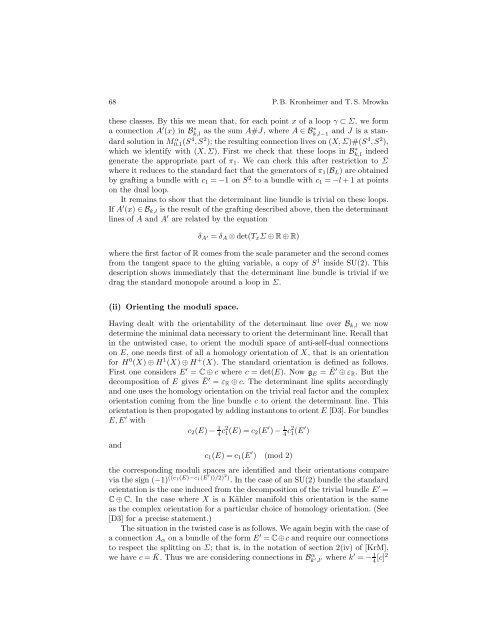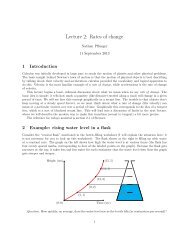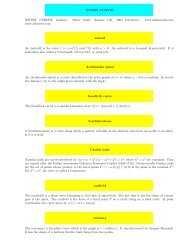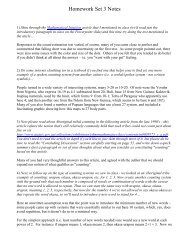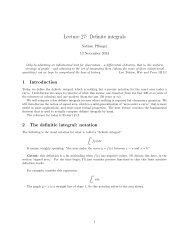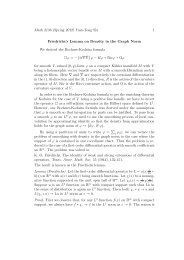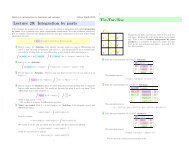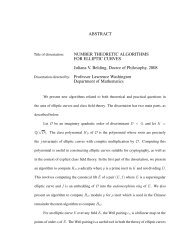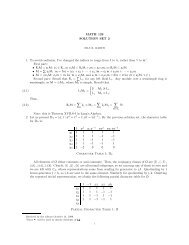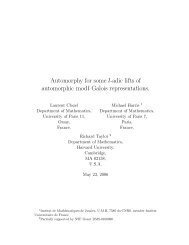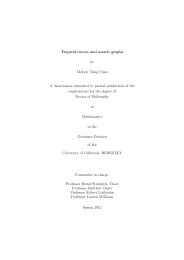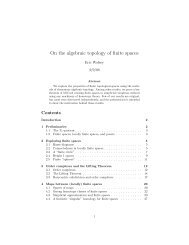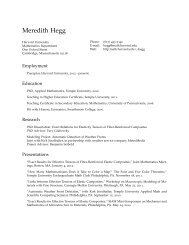Gauge theory for embedded surfaces, II
Gauge theory for embedded surfaces, II
Gauge theory for embedded surfaces, II
You also want an ePaper? Increase the reach of your titles
YUMPU automatically turns print PDFs into web optimized ePapers that Google loves.
68 P. B. Kronheimer and T. S. Mrowka<br />
these classes. By this we mean that, <strong>for</strong> each point x of a loop γ ⊂ Σ, we <strong>for</strong>m<br />
and J is a stan-<br />
a connection A ′ (x) inB∗ k,l as the sum A#J, whereA∈B∗ k,l−1<br />
dard solution in M α 0,1 (S4 ,S2 ); the resulting connection lives on (X,Σ)#(S4 ,S2 ),<br />
which we identify with (X,Σ). First we check that these loops in B∗ k,l indeed<br />
generate the appropriate part of π1. We can check this after restriction to Σ<br />
where it reduces to the standard fact that the generators of π1(BL) are obtained<br />
by grafting a bundle with c1 = −1 onS2to a bundle with c1 = −l +1 atpoints on the dual loop.<br />
It remains to show that the determinant line bundle is trivial on these loops.<br />
If A ′ (x) ∈Bk,l is the result of the grafting described above, then the determinant<br />
lines of A and A ′ are related by the equation<br />
δA ′ = δA ⊗ det(TxΣ ⊕ R ⊕ R)<br />
where the first factor of R comes from the scale parameter and the second comes<br />
from the tangent space to the gluing variable, a copy of S 1 inside SU(2). This<br />
description shows immediately that the determinant line bundle is trivial if we<br />
drag the standard monopole around a loop in Σ.<br />
(ii) Orienting the moduli space.<br />
Having dealt with the orientability of the determinant line over Bk,l we now<br />
determine the minimal data necessary to orient the determinant line. Recall that<br />
in the untwisted case, to orient the moduli space of anti-self-dual connections<br />
on E, one needs first of all a homology orientation of X, that is an orientation<br />
<strong>for</strong> H 0 (X) ⊕ H1 (X) ⊕ H + (X). The standard orientation is defined as follows.<br />
First one considers E ′ = C ⊕ c where c =det(E). Now gE = Ē′ ⊕ εR. Butthe<br />
decomposition of E gives Ē′ = εR ⊕ c. The determinant line splits accordingly<br />
and one uses the homology orientation on the trivial real factor and the complex<br />
orientation coming from the line bundle c to orient the determinant line. This<br />
orientation is then propogated by adding instantons to orient E [D3]. For bundles<br />
E,E ′ with<br />
c2(E) − 1<br />
4c21(E)=c2(E ′ )−1 4c21(E ′ )<br />
and<br />
c1(E)=c1(E ′ ) (mod 2)<br />
the corresponding moduli spaces are identified and their orientations compare<br />
via the sign (−1) ((c1(E)−c1(E′ ))/2) 2 ) . In the case of an SU(2) bundle the standard<br />
orientation is the one induced from the decomposition of the trivial bundle E ′ =<br />
C ⊕ C. In the case where X is a Kähler manifold this orientation is the same<br />
as the complex orientation <strong>for</strong> a particular choice of homology orientation. (See<br />
[D3] <strong>for</strong> a precise statement.)<br />
The situation in the twisted case is as follows. We again begin with the case of<br />
a connection Aα on a bundle of the <strong>for</strong>m E ′ = C⊕c and require our connections<br />
to respect the splitting on Σ; that is, in the notation of section 2(iv) of [KrM],<br />
we have c = ¯ K. Thus we are considering connections in B α k ′ ,l ′ where k′ = − 1<br />
4 [c]2


